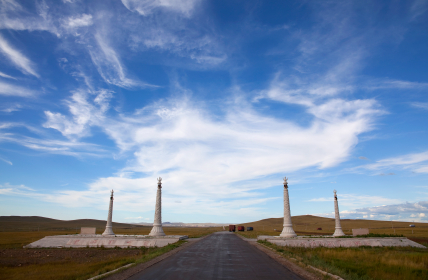Chronology
Much of the information contained in this was derived from the Jewish Life Weekly published in Harbin and they in turn obtained it from the archives of the Manchuria Jewish Community
The first Jews arrived in the settlement of Manchuria in 1902-1903. Manchuria at that time was a station on the CER. It's name today is Manzhouli. It boast s a population of over 1 million.
Towards the end of the Russo Japanese war of 1905 more Jews started to settle in Manchuria. By 1908, 25 Jewish families resided in the settlement. During the war communal life was at a minimum, but with the cessation of hostilities (of the Rosso-Japanese War) and the return of peace the community felt a need to maintain their religious and cultural heritage.
In 1910 the idea of constructing a permanent synagogue was fulfilled and a stone building constructed. It contained both a synagogue and a school (Heder) where only Jewish subjects were taught. Because of prevailing regulations the plot of land for the synagogue was purchased in the name of a private individual.
As the pogroms in Russia intensified, more Jew started to arrive in Manchuria. In 1913 the community was legally registered with the CER Отдела Управления Общества (КВЖД). The community called itself the Spiritual Community (Духовное). The persons were elected to represent the community. The were considered juristic persons vias-a-vis the CER administration. Because of the change in its status the community was able to transfer the land on which the Synagogue stood, in its name.
With the outbreak of the great war of 1914-198 a stream of refugees poured towards the East. The Jewish population increased to 150 families. The community center was permitted to issue all the required civil documents such as birth, marriage and death certificates.
In 1916 it was decided to build a Jewish School. The school was completed on 9 May 1917. The school opened its doors for tuition in October of 1917. It had 170 students and three teachers conducting Jewish studies and seven teachers for general subjects. The school was registered as a Jewish High School. The school functioned till 1929. Students graduating form the school were accepted to the fifth grade in the local gymnasium without examinations.
In the month of April 1917, after the Soviet revolution the Manchurian Jewish Community rose to 350 families. It is quite apparent that the lives of the early Jewish settlers in Northern China was initially interwoven with either their employment by the CER, or supplying services to the CER or escaping from one upheaval or another, that was the fate of Russian Jewry at that time.
In 1918 the idea of a Jewish Cooperative was floated. And indeed in April of that year the first Jewish Cooperative in the Far East opened its doors on the ground floor of a residential building -Communal Welfare as it was called. (ОБЩЕЕ БЛАГО). This organization provided al the advantages of a cooperative and served all the general public. It served to stabilize prices and the greatest benefit was derived by the poorer section of the population.
As the community grew it felt the need for a spiritual leader. To this goal a famous Rabbi Israel Rifa (Израил Рифа) from New Zagora (Нового Загора, Ковенской губернии) was invited to join the Community. As the community grew and prospered the First Zionist Committee, the Palestine Committee and other cultural committees were formed. In keeping with the Jewish tradition of benevolence a committee to take care of the sick and needy was also formed. (These committees and organizations were subsequently formed in most of the Jewish communities in China)
The Jewish school and library were established in 1918. Here again neither the school nor library were of bounds to non-Jews.
In the year 1920 the Jewish Community Committee was reformed and called the Manchurian Jewish Council (Советом Маньчжурской Еврейской общины). All the rights and obligations of the previous committee were transferred to the new Council which had a budget of 75,000 gold Rubles. The budget was formed by (a) a progressive levy (b) Charges for services rendered and (c) donations
Towards 1920 the Community was buffeted by external and internal events. Crack appeared in its fabric caused by the emigration of families to Palestine, Mongolia and other Far Eastern destinations.
By 1929 the community was left with 80 members and a budget of 2,500 Gold Rubles derived from dues and donations. The school was closed and only the library survived to about the 30's
The Jews were always active in the various self governing organs. M.Y Muiseev М.Я.Моисеев) and M. I. Dinaburg (М.И.Динабург) were the leading members from 1918.
As of the 30s the community ceased to exist. The only remnants . were some elderly and infirm members and some Jews who did not take part in communal activities. However both and Dinaburg remained till the end. Immovable property consisted of the Synagogue, a library containing 3500 tomes, the premises used as the school. As sad end to a vibrant and Jewish presence in this out of the way station on the Eastern branch of the CER.

